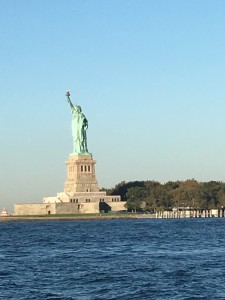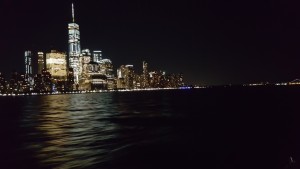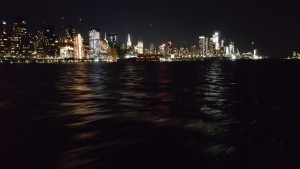You were born of the stars, dear girl; Stop settling for the dust they leave behind.
(Daniel Walsh)
On October 17th, I offered a Climate Action Now (CAN) program at the Ethical Culture Fieldston School in the Bronx for the school’s Environmental Club. The club has attracted a group of keen and eager students – young people who fully-know the bad news of what we are doing to our
environment, and who desperately want to hear the good news of what can be done and what they can do to be a part of the solution. Howie, a physics teacher and the club’s advisor, attended as well. I will be following-up with him to learn what specific actions the students are taking at their school to reduce carbon and other forms of pollution. Stay tuned for an inspiring story, as I told Howie that we want to publish their action(s) in a future blog. Note: for an inspiring story of how a group of Santa Monica high school students successfully banned polluting-plastic bags, check out this 6 minute Team Marine video (produced by the students).
After our CAN program, I met up with Steve, a life-long friend, who was joining me for our sailing trek from New York City to Washington, D.C. Once back to Tusen Takk, we broke out the charts and plotted a 450 nautical-mile course down the Hudson River, out to Sandy Hook, NJ with a plan to then “turn right,” as the seasoned mariners say, for an offshore jaunt to the Chesapeake Bay and up the Potomac River to D.C. Satisfied with course plotted, we went out to dinner at MamaJuana (a fun Bronx restaurant with tasty Dominican fare and a welcoming staff) then back to Tusen Takk to sail down the Hudson at night.
If you haven’t sailed the waters around, by or through a city at night, put it on your bucket list; it’s
magical. The city of New York was lit up like a pre-season Christmas Tree with the lights of skyscrapers sparkling in the distance and shimmering off the wind-swept water. From the gently flowing serenity of the river, there is a fresh perspective on a city: the hustle and bustle and sounds of cabs honking and sirens blaring gives way to the quiet-beauty and tranquil-stillness of a sea of lights reflecting over the water – inviting our open-mouthed and wonder-struck eyes to soak it all in. I couldn’t help but feel the inspiration of Frank Sinatra’s song New York, New York; Yes, “Start spread’n the news…”
After several hours on the Hudson soaking in the lit-beauty of New York, we scooted into a narrow
harbor at Hoboken, NJ around 12:30 a.m., docked, and shut our eyes for a few intermittent hours of sleep trying to compete with excited thoughts of adventures ahead… The next morning after a breakfast of sailor’s porridge (i.e. oatmeal loaded with whatever you feel inspired to add in the moment, and in this case: almonds, dried fruit, cinnamon, brown sugar, diced apple, milk), we headed out into New York Harbor, by Lady Liberty, around Staten Island, under the Verrazano Bridge, by Coney Island, around Sandy Hook and into 200 miles of sloggingly-slow beating into a southwest wind. We sailed down the coast of Jersey, by the skyline of Wilmington by Cape May and the Delaware Bay, by the wild horses of Chincoteague, into Chesapeake Bay and up the Potomac to D.C. There is too much to write about on a five-day sailing leg, including several through-the-night commitments, but let me highlight two experiences that remain fixed in memory.
After sunset and a thermos dinner of rice and beans (a trick I learned from the Boat Galley Cookbook where you heat up beans and rice in the morning, add some veggies and spices, and put the concoction in a pre-heated thermos to incubate all day), Steve suddenly exclaimed: “Hey, look at this!” From the safety of the cockpit, looking over the starboard rail, we could see the bow of Tusen Takk undulating up and down in a three-second rhythm of four-foot approaching seas. With each wave, she would ride up to the crest and down to the trough and into the next approaching wave. And as she crashed into each oncoming wave, she’d scatter countless sparks – pinpricks of light seemingly mirroring the stars above – like seeing a thousand fire flies in a field at night flashing in their own rhythm of bluish-white glow-light. It was an amazing moment.
The sparks we saw were actually tiny glowing specs of plankton. Through chemical reactions within their bodies, the plankton are able to glow, a process called bioluminescence. Chemicals in their bodies when mixed together by the motion of the sea excites other particles and generates the light which causes them to glow. It occurs in a variety of marine vertebrates and invertebrates, as well as in some microorganisms, fungi and land-based invertebrates like fireflies. For more information, check out this NOAA site What is bioluminescenc? Although “science” has an explanation for this phosphorescent phenomenon, for me, at that moment, it was simply pure magic.
Another indelible memory as I sat alone at 3 a.m. in the cockpit of Tusen Takk (one that conjures the emotion embedded in the slightly revised lyrics from Cats: “Memories, all alone in the starlight…), was our constellation travel companions shining brighter than usual as we sailed offshore with nothing vying for our attention but the rhythmic sound of sea lapping the hull… On a moonless night at sea, alone on watch without the presence of their younger, more dominant lunar cousin, the stars capture your full attention and imagination.
During our voyage, Steve and I each took 2 hour shifts at watch: while one was on duty, the other could rest, prepare a meal, or just hang out. At the end of my midnight shift, the constellation Orion was lying, as if sleeping, on the horizon to the southeast. When I began my 2 a.m. shift, however, the great Hunter had awoken, was standing proud and erect – armed with club, shield and sword dangling from his belt. Although alone on watch, I didn’t feel alone; I felt a kinship at sea with my celestial friend watching over us. I felt a connection with ancient mariners who, without the encumbrances of telescope and knowledge of modern astronomy, had thoughts winged to imagine the great Hunter’s exploits as they gazed over the rails of their hand-hewn ships. They, too, were not alone at watch at sea millennia ago, for they, too, had Orion as companion voicing his stories of adventure to a seemingly lone-mariner eager to listen.
It’s been asked: “What if the stars came out only once every two-thousand years?” Awe-struck, we would undoubtedly cease quarrelling, mundane concerns of life would evaporate, inspired poetry would be written, joyous songs and dancing would prevail… Our souls, unleashed from mortal-tethers, would soar in rapture-like-wonder, thoughts would leap from the rational and prudent to the realm of joyous imagination and spiritual curiosity…if the stars came out once every two-thousand years…
Oh, but the stars come out every night, and I have been guilty on a night like tonight, as a busy and confused by what is really important flat-lander, of not taking time to steal away from hypnotic technology or other distractions, to go outside, look up and let the awe and wonder of a star-studded-sky speak – while I am silent. For it is in silence that we hear the inner voice of who we are and why we are here…
So, I’ll carry these memories with me, not with a sense of anxiousness hoping not to lose them, but softly as gentle reminders of what I heard when the sea and stars spoke and I was silent and listened…
Did you know that with the naked eye one can see only about two thousand stars at one time under the best conditions? Want proof, go out and count them! OK, that was a ploy to lure you away from your phone and outdoors (smile)…
For more information on stars and constellations, check out H.A. Rey’s The Stars: A New Way to See Them – a simple, graphic method of getting acquainted with the magic in the sky. This book is wonder-full for families and children of all ages.
Bonus: A couple other memories from this voyage include witnessing: a bald eagle 50 yards off the port bow swoop down and grab a fish in its talons from the lower Potomac River; a posse of dolphins rounding up a school of fish for brunch at the mouth of the Chesapeake Bay; a pelican skimming the surface of a calm sea and scooping up fish off the shores of Chincoteague where wild horses still run free; ubiquitous fisherman casting their lines along the banks and shoals of so many creeks and rivers flowing into the Chesapeake; spectacular sunrises and sunsets framed only by water touching sky; the rapture of gratitude to be sharing all this with a friend who was equally eager to imbibe it all…
Stay tuned: Our next blog will recap a national climate conference we are attending in D.C. and perhaps some things you can do to reduce your carbon footprint.
To subscribe to (or unsubscribe from) these blog posts, write to jonathan@cellonline.org.
*CELL is currently accepting applications for college sustainability focused study abroad programs, to Iceland, Central America, Ecuador, and Scotland. Faculty and teachers can contact CELL regarding custom programs for your college or school. Go to cellonline.org for more information and to apply.”



